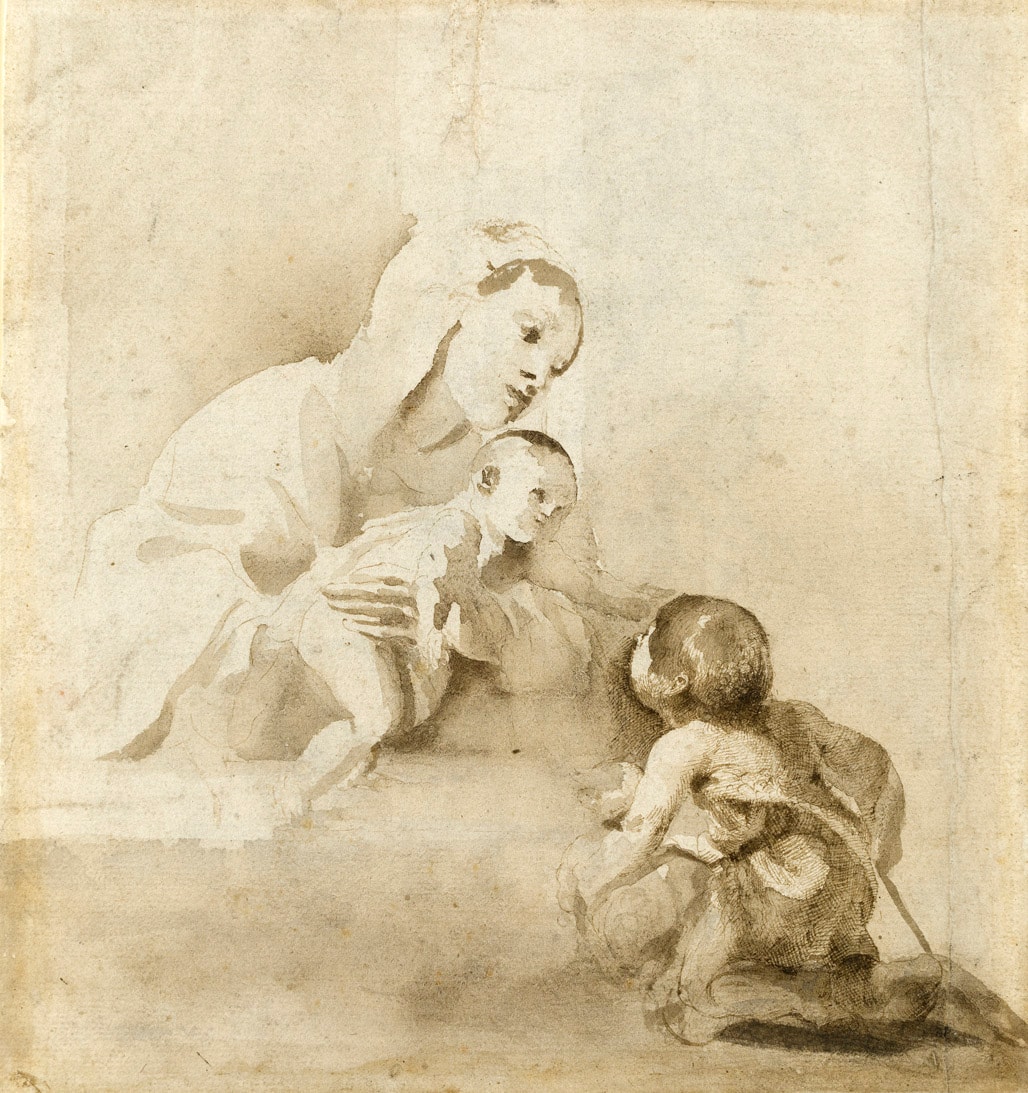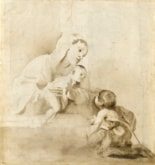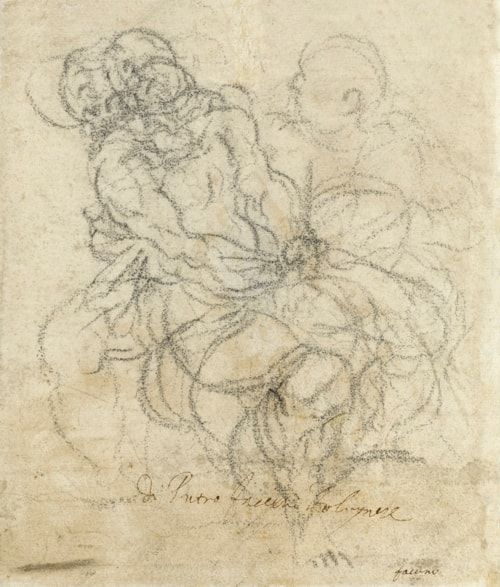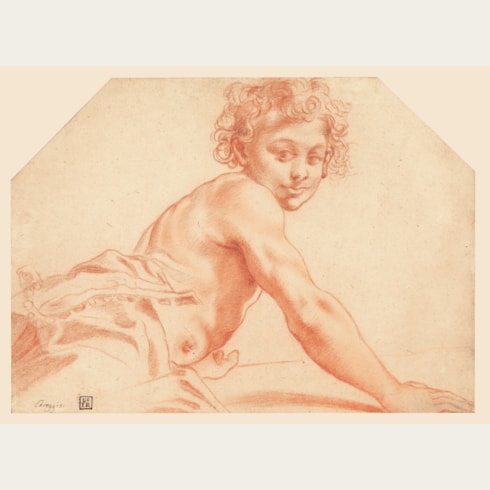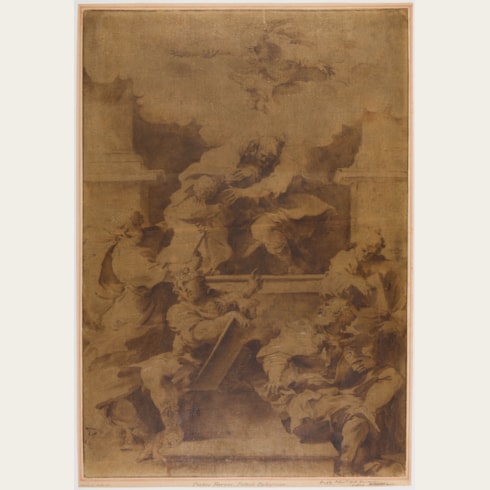Pietro FACCINI
(Bologna 1562 - Bologna 1602)
The Virgin and Child with the Young Saint John the Baptist [recto]; Study for a Deposition [verso]
Sold
Pen and brown ink and brown wash.
The verso in black chalk.
Inscribed di Pietro Faccini Bolognese and faccino on the verso.
218 x 203 mm. (8 5/8 x 8 in.)
The verso in black chalk.
Inscribed di Pietro Faccini Bolognese and faccino on the verso.
218 x 203 mm. (8 5/8 x 8 in.)
Although unrelated to any surviving painting, the present sheet is a splendid example of Faccini’s confident draughtsmanship. The use of broad areas of fluid wash to create effects of light in contrast to the areas of untouched white paper, as well as the relatively insubstantial forms of the figures themselves, is a characteristic feature of Faccini’s pen draughtsmanship of the late 1590’s. The areas of very fine pen hatching and crosshatching to add depth to the shadows, particularly evident in the drapery of the young Saint John the Baptist, have led to the tentative suggestion that the drawing may have been intended to have been reproduced as a print.
Stylistically comparable drawings include two studies for Faccini’s altarpiece of The Assumption of the Virgin in the Bolognese church of Santa Maria dei Servi; one in the Musée Calvet in Avignon and the other in the Louvre. Also comparable in technique and handling are two drawings of The Entombment of Christ and The Holy Family with Saints Francis and Dominic in the British Museum, as well as a pair of studies of The Holy Family Adored by Saint Francis in the Louvre and a study of The Holy Family with Saints Catherine of Siena and Dominic, also in the Louvre. A drawing of the Virgin and Child in Frankfurt, formerly given to Bartolomeo Schedoni but attributed to Faccini by Christel Thiem, is also comparable to the present sheet.
The rapidly drawn study in black chalk on the verso of this sheet may have been intended for a small devotional painting. Indeed, the drawing is close in composition to a late painting on copper by Faccini of Christ Supported by Angels, painted around 1600 and now in a private collection. Other drawings of a similar subject by Faccini, though different in composition, are in the Albertina in Vienna10 and the British Museum.
The late Mario di Giampaolo, who confirmed the attribution of this drawing to Faccini, further noted that the draughtsmanship of the black chalk study on the verso of the sheet bears similarities with that of Tintoretto. Like many of his contemporaries in Bologna, Faccini was influenced by the paintings and drawings of the Venetian masters, and in particular Tintoretto. A similarly free and spirited handling of chalk is found in part of the underdrawing of a study by Faccini of Two Saints with Putti in the Ashmolean Museum in Oxford.
Stylistically comparable drawings include two studies for Faccini’s altarpiece of The Assumption of the Virgin in the Bolognese church of Santa Maria dei Servi; one in the Musée Calvet in Avignon and the other in the Louvre. Also comparable in technique and handling are two drawings of The Entombment of Christ and The Holy Family with Saints Francis and Dominic in the British Museum, as well as a pair of studies of The Holy Family Adored by Saint Francis in the Louvre and a study of The Holy Family with Saints Catherine of Siena and Dominic, also in the Louvre. A drawing of the Virgin and Child in Frankfurt, formerly given to Bartolomeo Schedoni but attributed to Faccini by Christel Thiem, is also comparable to the present sheet.
The rapidly drawn study in black chalk on the verso of this sheet may have been intended for a small devotional painting. Indeed, the drawing is close in composition to a late painting on copper by Faccini of Christ Supported by Angels, painted around 1600 and now in a private collection. Other drawings of a similar subject by Faccini, though different in composition, are in the Albertina in Vienna10 and the British Museum.
The late Mario di Giampaolo, who confirmed the attribution of this drawing to Faccini, further noted that the draughtsmanship of the black chalk study on the verso of the sheet bears similarities with that of Tintoretto. Like many of his contemporaries in Bologna, Faccini was influenced by the paintings and drawings of the Venetian masters, and in particular Tintoretto. A similarly free and spirited handling of chalk is found in part of the underdrawing of a study by Faccini of Two Saints with Putti in the Ashmolean Museum in Oxford.
Pietro Faccini’s brief career seems to have begun at a relatively late age, when around 1583 he entered the Carracci academy in Bologna. His precocious talent is said to have aroused the jealousy of Annibale Carracci, however, and in the 1590’s Faccini left the Carracci academy, later setting up his own school. By this time he was already receiving independent commissions for altarpieces, and indeed the one known dated work by him, an early Martyrdom of Saint Lawrence painted for the Bolognese church of San Giovanni in Monte, was painted in 1590. He may have traveled to Venice, and the influence of Tintoretto noted by his biographer Cesare Malvasia is evident in some of his later works. According to Malvasia, Faccini was a productive painter known for his small-scale decorative pictures, although only a handful of paintings by him survive today. Held in high regard by his contemporaries, he was elected alongside Guido Reni and Francesco Albani as one of the fifteen consiglieri of the Compagnia dei Pittori in Bologna in 1599. One of his last major works was an altarpiece of The Assumption of the Virgin, painted for the church of Santa Maria dei Servi in Bologna. Although strongly influenced by both Annibale and Ludovico Carracci, Faccini developed a fairly idiosyncratic style, and unlike them had few obvious followers.
Aptly described by one scholar as ‘one of the most creative and original draughtsmen of the Emilian school’, Faccini worked in a variety of techniques, using pen and ink wash, red and black chalk, watercolour and oiled charcoal. He was an accomplished and versatile draughtsman, and his drawings were greatly admired for what Malvasia calls their ‘gran spirito’. They were especially popular with collectors, and Cardinal Leopoldo de’ Medici is said to have owned over a hundred drawings by the artist. Guercino also admired Faccini's drawings, which were a strong influence on his early chalk style, and is known to have possessed a number of ‘nudi d’accademia’ by the artist. In fact, Malvasia reserves special praise for Faccini’s drawings of the male nude, which he notes were often confused with those of Annibale Carracci: ‘so many drawings from the nude, that one sees an infinity of his models in all the most famous collections...so sensational, so darting, fluttering, and what is more, so easy and frank, that look as if they were by his master [ie. Annibale Carracci], many are sold every day as if the work of his hand.’ Important groups of drawings by Pietro Faccini, for the most part unpublished, are in the Uffizi, the Louvre, the Kupferstichkabinett in Berlin and the Galleria Estense in Modena.
Provenance
Private collection, France
Jean-Marie Le Fell, Paris, in 2001.

